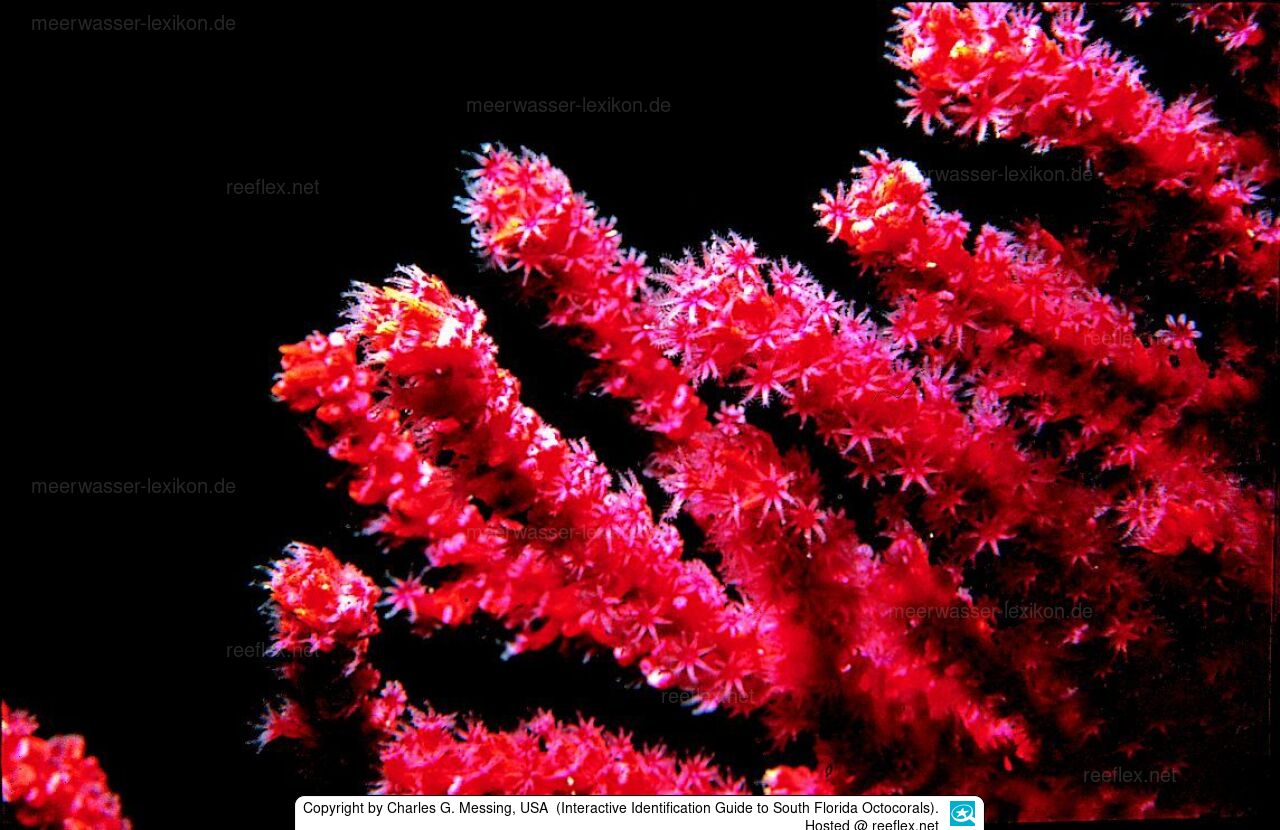Info
Very specíal thanks for the first photo of Eunicea tayrona to Prof. Dr. Charles G. Messing, Nova Southeastern University, USA.
Muricea pendula forms large, fan-shaped, pinnate colonies that branch in a plane.
The branches of the colourful coral are stiff and somewhat enlarged at the terminal branches, widely spaced, the branches arise at right angles from the main stems, soon twisting upwards, occasionally joining together.
Recommendation - the coral should be kept in a species-specific tank.
Feeding
Gorgonians do not have zooxanthellae and do not live off light. Azooxanthellate gorgonians do not host symbiotic algae that produce nutrients and energy through photosynthesis.
The pumps should be switched off before feeding. In order for the gorgonian to survive in the aquarium, each individual polyp must be fed sufficiently, i.e. daily or 3-4 times a week. Without feeding, the gorgonian will not survive in the aquarium. The polyps need a certain amount of time to absorb the food (granules or dust food (Ultramarin, Cyclop Eeze) or frozen food (lobster eggs, mysis)). If shrimp and fish are present, they will try to steal the food, so it is essential to feed these cohabitants beforehand.
Newly introduced gorgonian sticks can be stimulated with a liquid food, e.g., PolypLab Polyp, to encourage the individual polyps to open. Only then can feeding be carried out.
The better the individual polyps take up the food provided, the better the growth and reproduction rates will be.
Azooxanthellate corals eat suspensions, marine snow, microplankton, and other organic matter, which is their natural food.
Mucus: Muricea pendula does not form mucius.
Colour: Yellow or yellowish-brown, the stabilising sclerites are amber.
Habitat: Moderate to deep fore-reefs.
Remarks: Muricea pendula is very similar to Muricea pinnata, but differs in red colour-.
Muricea pendula lacks a terminal spine on the large pointed sclerites of the calyxes, the inner sclerites are larger and the terminal branches thicker.
Source: https://nsuworks.nova.edu/octocoral_m_pendula/
Muricea pendula forms large, fan-shaped, pinnate colonies that branch in a plane.
The branches of the colourful coral are stiff and somewhat enlarged at the terminal branches, widely spaced, the branches arise at right angles from the main stems, soon twisting upwards, occasionally joining together.
Recommendation - the coral should be kept in a species-specific tank.
Feeding
Gorgonians do not have zooxanthellae and do not live off light. Azooxanthellate gorgonians do not host symbiotic algae that produce nutrients and energy through photosynthesis.
The pumps should be switched off before feeding. In order for the gorgonian to survive in the aquarium, each individual polyp must be fed sufficiently, i.e. daily or 3-4 times a week. Without feeding, the gorgonian will not survive in the aquarium. The polyps need a certain amount of time to absorb the food (granules or dust food (Ultramarin, Cyclop Eeze) or frozen food (lobster eggs, mysis)). If shrimp and fish are present, they will try to steal the food, so it is essential to feed these cohabitants beforehand.
Newly introduced gorgonian sticks can be stimulated with a liquid food, e.g., PolypLab Polyp, to encourage the individual polyps to open. Only then can feeding be carried out.
The better the individual polyps take up the food provided, the better the growth and reproduction rates will be.
Azooxanthellate corals eat suspensions, marine snow, microplankton, and other organic matter, which is their natural food.
Mucus: Muricea pendula does not form mucius.
Colour: Yellow or yellowish-brown, the stabilising sclerites are amber.
Habitat: Moderate to deep fore-reefs.
Remarks: Muricea pendula is very similar to Muricea pinnata, but differs in red colour-.
Muricea pendula lacks a terminal spine on the large pointed sclerites of the calyxes, the inner sclerites are larger and the terminal branches thicker.
Source: https://nsuworks.nova.edu/octocoral_m_pendula/







 Prof. Dr. Charles G. Messing, (†), USA
Prof. Dr. Charles G. Messing, (†), USA



















